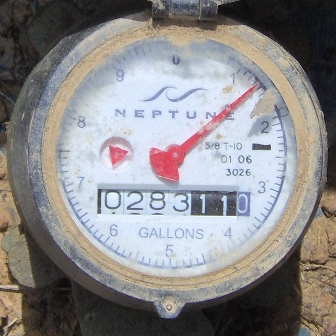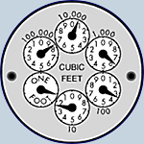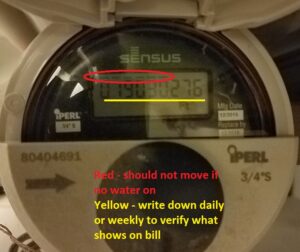 For many of us, we simply wait for the utility bill to show up, and never give it a second thought unless something just does not seem right. Now all of a sudden we are staring at this bill and we start asking questions like, did they read the meter right, do I have a leak, is someone stealing electricity, who, what, when, where, & how much again? In the next few articles, we are going to give you a basic primer on reading the four main types of meters in use today & a few helpful tips for possibly troubleshooting that dreaded “this just can’t be right…”
For many of us, we simply wait for the utility bill to show up, and never give it a second thought unless something just does not seem right. Now all of a sudden we are staring at this bill and we start asking questions like, did they read the meter right, do I have a leak, is someone stealing electricity, who, what, when, where, & how much again? In the next few articles, we are going to give you a basic primer on reading the four main types of meters in use today & a few helpful tips for possibly troubleshooting that dreaded “this just can’t be right…”
Two Main Measurement Types:
There are two main types of measurements used to measure water usage which is either by the gallon, or by the cubic foot. While one could assume that measuring by the cubic foot would only apply to large commercial customers, one would be wrong as it is basically decided by the water company which type they will use. In some cases, they might not have a choice, due to their billing systems &/or all the old meters still in use happen to be a certain type.
By the Gallon:
 In my case, our local water company utilizes one that measure water usage by the gallon and bills us based per 1000 gallons. Therefore, by looking at my meter above, you can see we have used 283,110 gallons since moving here and if they were to read our meter when this was taken, the bill would show 283 as our meter reading.
In my case, our local water company utilizes one that measure water usage by the gallon and bills us based per 1000 gallons. Therefore, by looking at my meter above, you can see we have used 283,110 gallons since moving here and if they were to read our meter when this was taken, the bill would show 283 as our meter reading.
A closer look at the meter:
- No matter which type of meter you have, the last 0 is generally stationary, and most utility companies only read the white section.
- If you want an accurate usage amount, you would simply replace the 0 with the location of the big red arrow
- Generally, the only reason, besides tracking daily usage, is if you were trying to determine if you might have a slow leak.
- In most cases the water main size & type is also shown on the display – in our case, just above the three black numbers, you will see three lines of text. The 5/8 T-10 shows it is a 5/8 water line and the meter is a t-10. The second line shows the date of manufacture & your guess is as good as mine on the final line.
- The small little red arrow, which maybe blue in some cases is referred to as a low flow meter & moves when water is going through the line.
The Cubic Foot Meter:
 The cubic foot meter is basically the same as the gallon meters, with the exception of the measurement and that they bill out at the 100 CF mark. A cubic foot of water contains 7.48 gallons, or as it is more commonly billed out at, 748 gallons per 100 Cubic Feet. Now one other interesting fact about this style of gauge is that the red needle will flip the last digit over when it hits .6 of a cubic foot. So based on the picture above – the actual reading is 2425.9 and as soon as it passes the 0 at the top, it will truly be 2426.X.
The cubic foot meter is basically the same as the gallon meters, with the exception of the measurement and that they bill out at the 100 CF mark. A cubic foot of water contains 7.48 gallons, or as it is more commonly billed out at, 748 gallons per 100 Cubic Feet. Now one other interesting fact about this style of gauge is that the red needle will flip the last digit over when it hits .6 of a cubic foot. So based on the picture above – the actual reading is 2425.9 and as soon as it passes the 0 at the top, it will truly be 2426.X.
An oldie but goodie:
 First, If anyone still has one of these in use, I would love to a picture of it as it has been at least 25 years since I have seen one like that. While I have not seen one though, I did include it as some locations still have not updated either infrastructure and there are rumors they are still in use. Just like the older style electric meters, you read it from left to right or clockwise, paying close attention to the fact that every other hand actually moves counterclockwise (it is a gearing & reduction issue). To read this meter or any like it, you begin with the largest dial (100,000 in this case) and read each dial down to the lowest one. If the hand is between numbers, you would use the lower number; in this case, you would read it as 806323 Cubic Feet. For billing purposes, you would probably see 8063, as it is a cubic feet meter – if it were a gallon meter, your bill would show up as 806.
First, If anyone still has one of these in use, I would love to a picture of it as it has been at least 25 years since I have seen one like that. While I have not seen one though, I did include it as some locations still have not updated either infrastructure and there are rumors they are still in use. Just like the older style electric meters, you read it from left to right or clockwise, paying close attention to the fact that every other hand actually moves counterclockwise (it is a gearing & reduction issue). To read this meter or any like it, you begin with the largest dial (100,000 in this case) and read each dial down to the lowest one. If the hand is between numbers, you would use the lower number; in this case, you would read it as 806323 Cubic Feet. For billing purposes, you would probably see 8063, as it is a cubic feet meter – if it were a gallon meter, your bill would show up as 806.
Using the meter to detect leaks:
As we mentioned above, most meters have a small red or blue arrow that spins as water moves past (low flow meter). The first test is to make sure anything that uses water is off like a shower, dishwasher, washing machines, etc… You would then simply walk down to the meter & see if there is any movement.
If there is no movement, you do not have a leak – if there is we need to start narrowing it down. One of the most notorious items is a toilet, so if you turn off those valves and the movement stops – you have found the cause. (Do not forget to turn the valves back on when you are done)
The second most common issue besides a leaky pipe inside the house (I am assuming you checked for dripping faucets & hose bibs already) is an underground leak. The easiest way to test for this is to see if your house has a secondary shutoff outside or maybe located just inside the house. If it does & you turn it off, it is time to cross your fingers & go check the meter again. If it has stopped you can stop worrying about digging up your yard, but now you have some investigating to do as the leak is somewhere between the fixtures & the shutoff.
One other issue you may wish to think about, is the under cabinet & outdoor Reverse Osmosis / Water Softener systems. You might want to make sure that no one uses the under cabinet one for an hour or so before testing (It take a while to process the water & for every gallon purified 3-8 gallons goes down the drain). For the Water softeners, just make sure it is not doing its cleaning cycle & you should be fine.
So what happens if you do not have a small arrow, or you think that it might be a really slow leak? The easiest thing in this case is to follow the steps above, place a sticker or mark at the location of the smallest measurement & walk away for an hour. If you have movement, you have a leak or someone forgot & washed their hands…
How about the new “Digital” Ones?
 I can’t say I like them, but many of the above types will be phased out over time with newer digital versions. What isn’t there to like? Well the biggest item for me is trying to detect leaks as you now have a bar that goes across instead of the “wheel.” The issue is it won’t show real tiny leaks until they trip the next bar which could take quite a while. Some may also complain that their usage magically goes up. Well in this case it isn’t that their usage has really gone up, just that their old meter wasn’t showing all the water that was being used.
I can’t say I like them, but many of the above types will be phased out over time with newer digital versions. What isn’t there to like? Well the biggest item for me is trying to detect leaks as you now have a bar that goes across instead of the “wheel.” The issue is it won’t show real tiny leaks until they trip the next bar which could take quite a while. Some may also complain that their usage magically goes up. Well in this case it isn’t that their usage has really gone up, just that their old meter wasn’t showing all the water that was being used.
Additional Info & Websites:
- HTRC: Monitoring your usage with Smart Meters & MyUsage
- HTRC: Free spreadsheet to help you monitor your utility usage & gas mileage
- HTRC: Reading your Water, Electric, Gas, Propane Meters

I like this series of articles of yours on how to read meters. All very clearly explained, and removes much of the mystery. Our water company installed a new digital water meter just about two weeks ago: http://twitpic.com/4brqlm The display automatically alternates between the current rate and CFM: http://twitpic.com/4brolp . I’m wondering if the new meter is wireless??
Those are pretty cool looking & yes it does: & based off the FAQ it holds up to 96 days of hourly usage, it detects reverse flow & for leak detection – it has a solid faucet that shows up for continual leak & a flashing one saying it detected an intermitent leak in the last 24 hours
The 9th digit & the flow sign are ways of checking for leakage
Wow..that’s all pretty cool. A smart meter! (Almost). Thanks for the link. I’ll be studying this further. Now, if the water company would allow me access to the data, I could measure the effectiveness of my water saving enhancements over time. The meter was installed about a week or two before I started with the low gpm fixtures.
Those are pretty cool looking & yes it does: & based off the FAQ it holds up to 96 days of hourly usage, it detects reverse flow & for leak detection – it has a solid faucet that shows up for continual leak & a flashing one saying it detected an intermitent leak in the last 24 hours
The 9th digit & the flow sign are ways of checking for leakage
Wow..that’s all pretty cool. A smart meter! (Almost). Thanks for the link. I’ll be studying this further. Now, if the water company would allow me access to the data, I could measure the effectiveness of my water saving enhancements over time. The meter was installed about a week or two before I started with the low gpm fixtures.
I like this series of articles of yours on how to read meters. All very clearly explained, and removes much of the mystery. Our water company installed a new digital water meter just about two weeks ago: http://twitpic.com/4brqlm The display automatically alternates between the current rate and CFM: http://twitpic.com/4brolp . I’m wondering if the new meter is wireless??